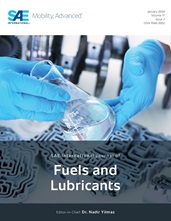The hydrocarbons constituting the heavy tail of gasoline are key contributors to
particulate matter (PM) emissions from spark-ignition (SI) engines. They are
predominantly aromatic and, to a significant degree, bicyclic aromatic. For
example, above a boiling point of 400°F, the content of bicyclic compounds in
the United States (US) summer regular-grade E10 gasoline exceeds 50%v.
Various gasoline parameters, such as the PM Index, Particulate Evaluation Index
(PEI), Particulate and Soot Correlation Equation (PASCE), or Threshold Sooting
Index (TSI), have been proposed as predictors of PM emissions from SI engines.
In particular, the PM Index, whose value is dominated by the content of heavy
aromatics and which, so far, has yielded the most predictive PM emissions
models, appears to be the best metric to achieve this objective. However, the
calculation of its value for any gasoline requires knowledge of the
compositional profile of that fuel, which, in turn, calls for a detailed
hydrocarbon analysis (DHA) of the fuel. Unfortunately, the DHA is a
sophisticated, time-consuming, and costly gas chromatographic (GC) method.
Therefore, alternative approaches are being explored.
A novel method of assessing and reducing the impact of heavy gasoline fractions
on PM emissions from SI engines is being proposed in this article. It is based
on the GC simulated distillation (SimDis) method which, unlike the DHA, is fast,
simple, and inexpensive. SimDis also has the important ability to directly link
existing gasoline DHA databases to PM Index-based emissions models to assess PM
emission impacts.
